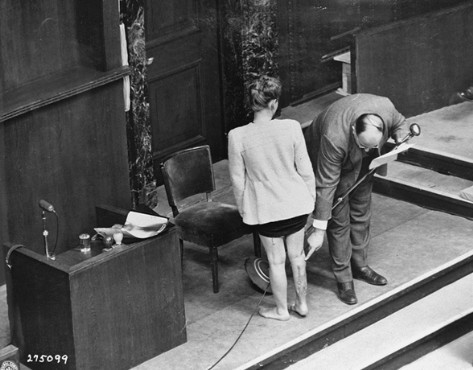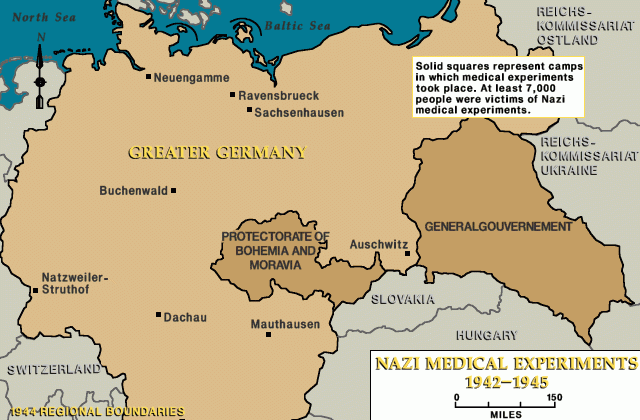
Nazi Medical Experiments
During World War II, a number of German physicians conducted painful and often deadly experiments on thousands of prisoners without their permission. Considering the inhumane conditions, lack of consent, and questionable research standards, modern scientists overwhelmingly reject the use of results from experiments in the camps.
Key Facts
-
1
Many German physicians and scientists supported racial hygiene ideas before the Nazi rise to power. From 1933 on, they embraced the new regime’s emphasis on biology and heredity, the new career opportunities, and the additional funding for research.
-
2
Experiments centered around three topics: survival of military personnel, testing of drugs and treatments, and the advancement of Nazi racial and ideological goals.
-
3
After the war, only a few of the biomedical experts who helped to implement and to legitimize Nazi racial hygiene policies were ever indicted or disciplined professionally. Many continued their careers.
Role of the Medical Profession
From 1933 to 1945, Nazi Germany carried out a campaign to "cleanse" German society of individuals viewed as biological threats to the nation's "health." The Nazis enlisted the help of physicians and medically trained geneticists, psychiatrists, and anthropologists to develop racial health policies. These policies began with the mass sterilization of many people in hospitals and other institutions and ended with the near annihilation of European Jewry.
Medical Experiments in the Third Reich

Unethical medical experimentation (without patient consent or any safeguards) carried out during the Third Reich may be divided into three categories.
1. Experiments dealing with the survival of military personnel
Many experiments in the camps intended to facilitate the survival of Axis military personnel in the field. For example, at Dachau, physicians from the German air force and from the German Experimental Institution for Aviation conducted high-altitude experiments on prisoners to determine the maximum altitude from which crews of damaged aircraft could parachute to safety. Scientists there also carried out so-called freezing experiments on prisoners to find an effective treatment for hypothermia. Prisoners were also used to test various methods of making seawater drinkable.
2. Experiments to test drugs and treatments

Other experiments aimed to develop and test drugs and treatment methods for injuries and illnesses which German military and occupation personnel encountered in the field. At the German concentration camps of Sachsenhausen, Dachau, Natzweiler, Buchenwald, and Neuengamme, scientists used camp inmates to test immunization compounds and antibodies for the prevention and treatment of contagious diseases, including malaria, typhus, tuberculosis, typhoid fever, yellow fever, and infectious hepatitis. Physicians at Ravensbrück conducted experiments in bone-grafting and tested newly developed sulfa (sulfanilamide) drugs. At Natzweiler and Sachsenhausen, prisoners were exposed to phosgene and mustard gas in order to test possible antidotes.
3. Experiments to advance Nazi racial and ideological goals
A third category of medical experimentation sought to advance the racial and ideological tenets of the Nazi worldview. The most infamous were the experiments of Josef Mengele on twins of all ages at Auschwitz. He also directed experiments on Roma (Gypsies), as did Werner Fischer at Sachsenhausen, to determine how different "races" withstood various contagious diseases. The research of August Hirt at Strasbourg University also intended to establish "Jewish racial inferiority." Additional gruesome experiments meant to further Nazi racial goals included a series of sterilization experiments, undertaken primarily at Auschwitz and Ravensbrück. Scientists tested a number of methods in an effort to develop an efficient and inexpensive procedure for the mass sterilization of Jews, Roma, and other groups Nazi leaders considered to be racially or genetically undesirable.
The Nuremberg Code
The Nuremberg Code was created in the aftermath of the discovery of the camp experiments and subsequent trials to address abuses committed by medical professionals during the Holocaust. The Nuremberg Code included the principle of informed consent and required standards for research.
Critical Thinking Questions
How did medical professionals justify medicalized killing and experimentation on humans during the Holocaust?
How do contemporary medical practices counter these justifications and protect the subjects of medical experiments?
What are the reasons for and against using research data from these experiments?

